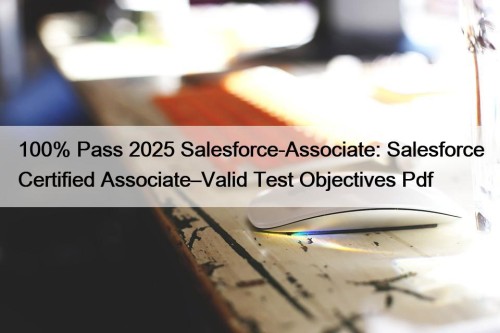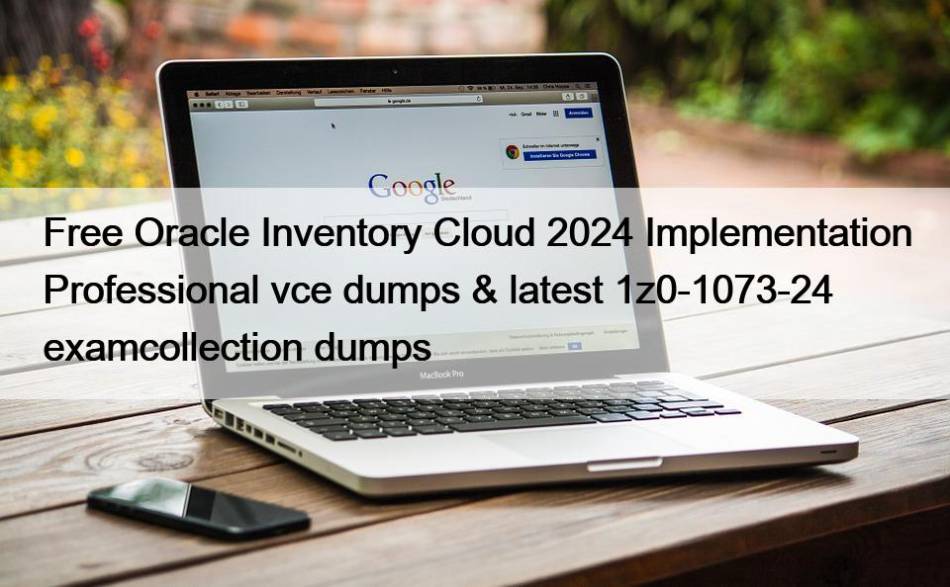Most Popular
 100% Pass 2025 Salesforce-Associate: Salesforce Certified Associate–Valid Test Objectives Pdf
100% Pass 2025 Salesforce-Associate: Salesforce Certified Associate–Valid Test Objectives Pdf
P.S. Free 2025 Salesforce Salesforce-Associate dumps are available on Google ...
 1z0-1073-24 Exam Passing Score | 1z0-1073-24 Test Simulator Fee
1z0-1073-24 Exam Passing Score | 1z0-1073-24 Test Simulator Fee
May be there are many study materials for Oracle certification ...
 Quick and Easiest Way of Getting Supermicro SMI300XS Certification Exam
Quick and Easiest Way of Getting Supermicro SMI300XS Certification Exam
Successful people are those who never stop advancing. They are ...



Free Oracle Inventory Cloud 2024 Implementation Professional vce dumps & latest 1z0-1073-24 examcollection dumps

Do you have registered for the Oracle 1z0-1073-24 exam and are worried about Oracle 1z0-1073-24 exam preparation? Try Oracle 1z0-1073-24 PDF Questions and practice tests which help you prepare the whole course in less duration. The Oracle 1z0-1073-24 practice test material gives you a clear idea to prepare for the Oracle 1z0-1073-24 Exam and saves you preparation time. An 1z0-1073-24 exam is a time-based exam, and the candidate must be fast enough to solve the problems in a limited time.
Oracle 1z0-1073-24 Exam Syllabus Topics:
| Topic | Details |
|---|---|
| Topic 1 |
|
| Topic 2 |
|
| Topic 3 |
|
| Topic 4 |
|
| Topic 5 |
|
| Topic 6 |
|
| Topic 7 |
|
| Topic 8 |
|
| Topic 9 |
|
>> 1z0-1073-24 Exam Testking <<
Frenquent Oracle 1z0-1073-24 Update - 1z0-1073-24 Labs
Through a large number of simulation tests, you can rationally arrange your own 1z0-1073-24 exam time, adjust your mentality in the examination room, find your own weak points and carry out targeted exercises. But I am so sorry to say that 1z0-1073-24 test answers can only run on Windows operating systems and our engineers are stepping up to improve this. In fact, many people only spent 20-30 hours practicing our 1z0-1073-24 Guide Torrent and passed the exam. This sounds incredible, but we did, helping them save a lot of time.
Oracle Inventory Cloud 2024 Implementation Professional Sample Questions (Q56-Q61):
NEW QUESTION # 56
Which two statements are true about project-driven supply chain?
- A. Common inventory cannot be used for project-specific picks.
- B. Project and task details can be removed from a referenced return.
- C. Project and task details are not available on the Manage Item Quantities page.
- D. Exclusion can be set for project cost collection by project type.
Answer: B,D
NEW QUESTION # 57
Vision Corporation manufactures two products, Air Compressors and Air Filters, in its factory unit. It also provides two services, Electrical Services and Mechanical Services, for its customers. The company submits profit and loss statements for each of its products and services separately.
Vision Corporation is located in the UK and submits its reports using UK Statements of Standard Accounting Practice and Financial Reporting standards.
Which is a suitable enterprise configuration for Vision Corporation?
- A. 1 Business Unit, 1 Ledger, and 1 Legal Entity
- B. 4 Business Units, 1 Ledger, and 1 Legal Entity
- C. 2 Business Units, 1 Ledger, and 1 Legal Entity
Answer: B
NEW QUESTION # 58
Which functionalities are part of Supply Chain Orchestration? (Choose four)
- A. launching and managing complex business processes
- B. performing automated change management to match supply to demand
- C. receiving supply requests from several sources operating in Oracle Cloud
- D. providing a 360-degree view of the supply-creation process
- E. providing supply requests to Fusion Planning Central
Answer: A,B,C,D
NEW QUESTION # 59
You created a consigned agreement with a supplier. The supplier shipped the goods, which you received in your receiving area. After two days, you transferred the goods from receiving into your inventory and used it for your interorganization transfer order.Where is the ownership of the goods?
- A. The ownership is with the buyer due to interorganization consigned inventory movement.
- B. The ownership is with the supplier because the supplier has not sent the consumption advice.
- C. The ownership is with the supplier because the goods are not yet consumed.
- D. The ownership changes from the supplier to the buyer as soon as the goods are received in the receiving area.
Answer: A
NEW QUESTION # 60
Set Up Back-to-Back Transfer Flow
The topic explains what you need to do for setting up back-to-back transfer flow.
In the Oracle Product Information Management, ensure that the Item is Back-to-Back enabled.
In Oracle Global Order Promising:
1.Set up a global sourcing rule with Type as Transfer from. Set the organization as the organization requesting the transfer (example, Warehouse 1).
2.Set up a local sourcing rule for the organization (in this example, Warehouse 1) Type as Transfer from, from the organization that has the stock from which the transfer will take place (example, Warehouse 2).
3.Set up an ATP rule with the Promising Mode as Supply chain availability search.
4.Ensure that the Supply chain availability search attributes are enabled according to your requirements. For example, you might want the application to search components and resources to include on-hand or in-transit Supply Types or fulfillment lines Demand Types.
5.Set the ATP Rule Assignment as required.
6.Set the sourcing assignments for the sourcing rules that you defined in steps 1 and 2.
7.Ensure that the assignment level used for the global sourcing rule doesn't include any Organization.
8.Refresh and restart the Order Promising Server for ATP Rules and Sourcing.
With this setup:
*The global rule is used to source the item from Warehouse 1 if there is stock available to reserve.
*If there's no stock on hand, Global Order Promising uses the local rule to transfer the item from Warehouse 2 to Warehouse 1.
Answer:
Explanation:
See the Explanation for the complete solution.
Explanation:
Set Up Back-to-Back Transfer Flow in Oracle Cloud
The Back-to-Back (B2B) Transfer Flow allows organizations to move inventory from one warehouse (source) to another warehouse (destination) when stock is unavailable in the fulfillment location. This setup ensures that Oracle Global Order Promising (GOP) can automatically determine the best supply source and execute the transfer process efficiently.
1. Prerequisites: Enable Back-to-Back for Items
Before setting up the transfer flow, ensure that the item is Back-to-Back enabled in Oracle Product Information Management (PIM):
* Navigate to Oracle Product Information Management (PIM).
* Search for the item you want to enable for back-to-back fulfillment.
* In the item definition, enable the "Back-to-Back Enabled" attribute.
* Save and publish the item updates.
# This ensures that the item can participate in the B2B fulfillment process.
2. Configure Global Order Promising (GOP) for Back-to-Back Transfer Flow In Oracle Global Order Promising (GOP), configure the system to determine the best transfer source when fulfilling back-to-back orders.
Step 1: Create a Global Sourcing Rule (Type: Transfer From)
* Navigate to Oracle Global Order Promising (GOP).
* Create a Global Sourcing Rule with the following details:
* Type: "Transfer From"
* Source Organization: Warehouse 1 (Requesting warehouse or fulfillment location).
# This rule ensures that items are sourced from Warehouse 1 whenever stock is available.
Step 2: Create a Local Sourcing Rule (Type: Transfer From)
* Create a Local Sourcing Rule for Warehouse 1 as follows:
* Type: "Transfer From"
* Source Organization: Warehouse 2 (Stock-holding warehouse).
# This rule ensures that if Warehouse 1 does not have stock, the system transfers items from Warehouse 2.
Step 3: Set Up an ATP Rule for Availability Check
* Create an ATP Rule (Available-to-Promise Rule) with the following parameters:
* Promising Mode: "Supply Chain Availability Search".
* Enable attributes for supply chain availability search based on business needs.
* Configure ATP search to consider on-hand stock, in-transit inventory, components, and resources if needed.
# This ensures that GOP can evaluate stock levels across multiple locations.
Step 4: Assign ATP Rule to Organizations
* Assign the ATP Rule to the appropriate organizations.
* Ensure that the rule applies to Warehouse 1 and Warehouse 2 based on their roles in the sourcing process.
# This enables availability checking when processing sales orders.
Step 5: Assign Sourcing Rules to Organizations
* Assign the Global Sourcing Rule to the enterprise-wide sourcing assignment.
* Assign the Local Sourcing Rule to Warehouse 1, specifying Warehouse 2 as the sourcing location.
* Ensure that the assignment level for the global sourcing rule does not include a specific organization (it should apply at a broader level).
# This ensures that Oracle GOP prioritizes sourcing stock from Warehouse 1 first and transfers from Warehouse 2 if needed.
Step 6: Refresh and Restart Order Promising Server
* Once the sourcing rules and ATP configurations are in place:
* Refresh Oracle Global Order Promising (GOP) Rules.
* Restart the Order Promising Server to apply sourcing and ATP rule changes.
# This step ensures that all updates take effect and are used in future order promising decisions.
3. Expected Behavior After Setup
* If Warehouse 1 has stock # GOP reserves inventory and processes the sales order immediately.
* If Warehouse 1 does not have stock # GOP triggers a transfer order to move stock from Warehouse 2 to Warehouse 1.
* Once the transfer order is fulfilled and received, the sales order is shipped to the customer.
# This ensures automated order fulfillment with minimal manual intervention.
4. Benefits of Back-to-Back Transfer Flow in Oracle Cloud
# Optimized Inventory Utilization - Uses stock efficiently across multiple warehouses.# Automated Stock Transfers - Eliminates manual intervention by automatically moving stock when needed.# Reduced Procurement Costs - Moves existing inventory instead of purchasing new stock.# Faster Order Fulfillment
- Reduces lead times by sourcing from internal stock before procurement.# Seamless Oracle Cloud Integration - Works across Oracle Order Management, Inventory, GOP, and Supply Chain Orchestration.
NEW QUESTION # 61
......
Before you place orders, you can download the free demos of 1z0-1073-24 practice test as experimental acquaintance. Once you decide to buy, you will have many benefits like free update lasting one-year and convenient payment mode. We will inform you immediately once there are latest versions of 1z0-1073-24 Test Question released. And if you get any questions, please get contact with us, our staff will be online 24/7 to solve your problems all the way.
Frenquent 1z0-1073-24 Update: https://www.2pass4sure.com/Inventory-Management-Cloud/1z0-1073-24-actual-exam-braindumps.html
- Three Easy-to-Use Oracle 1z0-1073-24 Exam Dumps Formats 🏟 Search for 【 1z0-1073-24 】 and easily obtain a free download on { www.real4dumps.com } 🙊Test 1z0-1073-24 Simulator Fee
- The best 1z0-1073-24 Exam Testking – The Latest Frenquent Update for Oracle 1z0-1073-24 🌼 Open ▷ www.pdfvce.com ◁ and search for 【 1z0-1073-24 】 to download exam materials for free 🎡Practice 1z0-1073-24 Mock
- 1z0-1073-24 Exam Introduction ⛺ Valid 1z0-1073-24 Braindumps 🌲 Test 1z0-1073-24 Simulator Fee 🏆 Open ☀ www.testsimulate.com ️☀️ and search for ⏩ 1z0-1073-24 ⏪ to download exam materials for free 🥊Valid 1z0-1073-24 Braindumps
- Three Easy-to-Use Oracle 1z0-1073-24 Exam Dumps Formats 🧁 Simply search for “ 1z0-1073-24 ” for free download on ✔ www.pdfvce.com ️✔️ 🛺Practice 1z0-1073-24 Mock
- Intereactive 1z0-1073-24 Testing Engine 🌾 Test 1z0-1073-24 Simulator Fee 💂 Free 1z0-1073-24 Updates 🕘 Search for ⏩ 1z0-1073-24 ⏪ and obtain a free download on ☀ www.lead1pass.com ️☀️ 📉Intereactive 1z0-1073-24 Testing Engine
- 1z0-1073-24 Latest Examprep 👶 New 1z0-1073-24 Braindumps Pdf ✒ New 1z0-1073-24 Braindumps Pdf 📶 Copy URL ⇛ www.pdfvce.com ⇚ open and search for ( 1z0-1073-24 ) to download for free 🔩1z0-1073-24 Exam Quizzes
- Oracle 1z0-1073-24 Exam Testking: Oracle Inventory Cloud 2024 Implementation Professional - www.passcollection.com Ensure you a High Passing Rate 🤹 Open website “ www.passcollection.com ” and search for ➠ 1z0-1073-24 🠰 for free download 🍥1z0-1073-24 Exam Questions And Answers
- 1z0-1073-24 Exam Questions And Answers 🚒 Free 1z0-1073-24 Updates 🥕 New 1z0-1073-24 Braindumps Pdf 🎸 Open website 【 www.pdfvce.com 】 and search for ( 1z0-1073-24 ) for free download 🔃1z0-1073-24 Exam Tips
- 1z0-1073-24 Exam Questions And Answers 🐳 1z0-1073-24 Exam Tips 🆘 1z0-1073-24 Download Free Dumps 🧫 Open website ⏩ www.dumps4pdf.com ⏪ and search for 【 1z0-1073-24 】 for free download 🎬Reliable 1z0-1073-24 Test Cram
- Providing You Authoritative 1z0-1073-24 Exam Testking with 100% Passing Guarantee 🥦 Immediately open ⏩ www.pdfvce.com ⏪ and search for ▶ 1z0-1073-24 ◀ to obtain a free download 📮1z0-1073-24 Advanced Testing Engine
- Practice 1z0-1073-24 Mock 🧉 Valid 1z0-1073-24 Braindumps 🤛 1z0-1073-24 Exam Questions And Answers ✨ Go to website ✔ www.lead1pass.com ️✔️ open and search for ➡ 1z0-1073-24 ️⬅️ to download for free 🏁1z0-1073-24 Download Free Dumps
- 1z0-1073-24 Exam Questions
- learn.magicianakshaya.com thephilatherapynetwork.com geek.rocketcorp.com.br thesohamacademy.com ydshifu.top libmentor.com mpgimer.edu.in digiworldwise.online yuanshuoacademy.com korodhsoaqoon.com
Tags: 1z0-1073-24 Exam Testking, Frenquent 1z0-1073-24 Update, 1z0-1073-24 Labs, New 1z0-1073-24 Dumps Sheet, 1z0-1073-24 Exam Fees